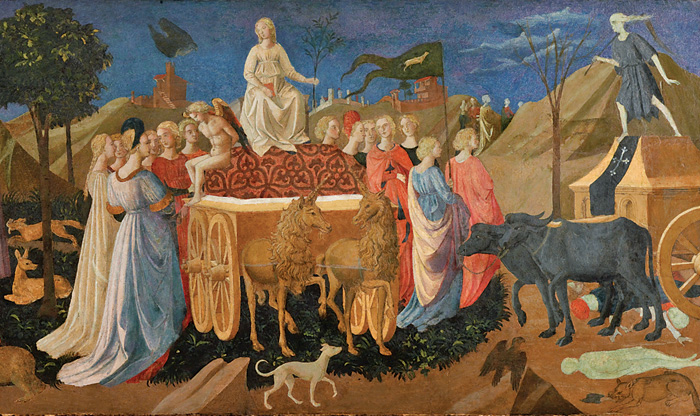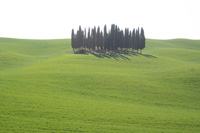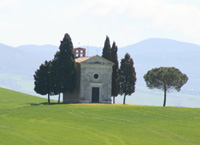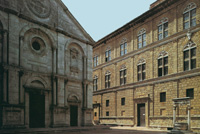| |
|
Francesco Pesellino (probably 1422-July 29, 1457), also known as Francesco di Stefano, Il Pesellino, Francesco Peselli, and Francesco di Stefano Pesellino was an Italian (Florentine) painter. His father was the painter Stefano di Francesco (died 1427), and his maternal grandfather was the painter Giuliano Pesello (1367-1446), from whose name the diminutive nickname of "Pesellino" arose. After the death of his father in 1427, the young Francesco Pesellino went to live with his grandfather, Giuliano Pesello, adopting his name. Francesco Pesellino remained in his grandfather’s studio until the latter’s death, when he joined the studio of Filippo Lippi (ca.1406-1469). He married in 1442, and probably joined the Florence painters' guild in 1447. In the following years he made a reputation with small, highly finished, works, either religious subjects for predellas or private devotions, or secular subjects, often for insetting into furniture or panelling.
Pesellino died in Florence in 1457, at only 35, cutting short a career with great promise. His style "anticipates the developments of later Florentine painters such as Verrocchio and the Pollaiuoli".
According to Vasari, he painted the predella scenes to an altarpiece by Lippi for Santa Croce; these are now divided between the Uffizi, Louvre, and Bergamo. His only surviving securely documented work, and his only recorded large-scale work, is an altarpiece with predella of the Trinity (National Gallery, London), which was only half complete at his death, and was finished by Filippo Lippi and his workshop. The main panel, nearly square at over 1.8m in each dimension, shows the Trinity in the Throne of Mercy motif, flanked by four standing saints, and angels. One predella panel is in the Hermitage, St Petersburg. The commission is unusually well documented, to which records of the litigation between Pesellino's widow and his business partner over the money due for the incomplete work can be added, and the records are much cited by art historians. The work was first decided upon in 1455 by the commissioners, the confraternity of priests at Pistoia, and they did not finally receive it until 1460. Drawings for the work also survive. The altarpiece was later cut up into six parts, probably in the eighteenth century, and has now been reassembled, with one section reconstructed, and another on loan from the Royal Collection.
A number of other paintings, now lost, hung in prominent positions in the Palazzo Medici and the Medici Casa Vecchia, and at least one work by Pesellino hung in the same room as Paolo Uccello's Battle of San Romano. Some surviving panel paintings have been identified as his by stylistic comparison with the altarpiece, including two long horizontal panels with the Story of David and Goliath and the Triumph of David, probably from cassoni (also National Gallery, London).[3] Other cassoni pieces are in and Bergamo and Boston, whilst the Metropolitan Museum of Art and Toledo, Ohio have other works. A small diptych of the Annunciation in the Courtauld Institute is a good example of the cabinet paintings that made his reputation. The Hermitage also has six very beautiful full-page miniatures from an illuminated manuscript. |
 |
Francesco Pesellino (1422–1457), Triumphs of Love, Chastity, and Death, c. 1450, Isabella Stewart Gardner Museum, Boston
|
| Francis Petrarch’s poem cycle The Triumphs, c. 1370, provides the subject matter for this chest. |
|
|
|
| |
|

[1] Fra Filippo Lippi was one of the most famous Florentine painters in his time. Among his patrons who commissioned paintings and frescoes were the most powerful families of Florence, including the Medici. He combined Gothic vocabulary of form with the achievements of the Renaissance such as a central perspective and a corporeity of figures. Among his pupils were Sandro Botticelli and his son Filippino Lippi.
[2] During the 14th century there was an artistic and cultural revolution. The main thrust of this transformation, which started in the city-states of northern Italy, was a revived confidence in the power and dignity of humanity. Society began to examine contemporary artists in light of classical antiquity.
It was at this time that society began to admire artists as inspired creators, and their social status was elevated by the patronage extended by popes and other influential figures in Rome. In Florence, the vision of a new art with a passion for realism began to dominate the minds of the Italian masters.
The "universal" or "Renaissance" man was well read in the classical texts; he could also master the complexities of engineering, science and military works. Growing attention to anatomy and perspective allowed sculptors and architects to fashion three-dimensional forms with greater assurance than ever before. Furniture-makers were inspired to blend architectural columns, pilasters and pediments with motifs from the rich and varied classical repertoire into their lavishly decorated constructions. In the search for an alternative to the dominant Gothic esthetic, the glamour of the new Italian achievement became irresistibly appealing throughout all Europe.
To the visitor from England or France, the great palaces of Florence, Venice, Genoa, Milan and Rome must have seemed unbelievably rich and luxurious. The walls of the main rooms were often frescoed by the greatest artists; ceilings were boldly carved and nearly always gilded; floors were inlaid with marble. There was an abundance of costly fabrics. Sideboards were decked with massive, intricately wrought silver ewers and basins. In the smaller rooms there might be oil paintings on the walls, exquisite little bronze statuettes on tables, and less finely worked bronze andirons in the fireplace.
Cassoni – marriage chests – were the most elaborate pieces of furniture to be found in an Italian palace in the early 16th century. They were made by craftsmen who seem to have held themselves rather above the common falegnami -- household carpenters and joiners responsible for the rougher objects of furniture -- and belonged to a separate guild.
These cassoni were made to contain a bride's trousseau and were decorated not only with the coats of arms of her family and those of her intended husband, but with relief ornament, swags of fruit, panels of wooden mosaic in patterns (intarsia) or narrative paintings taken from the Bible and classical mythology. Often they were made in pairs.
The painted, carved and gilded "Conquest of Trebizond" chest at the Metropolitan Museum of Art in New York City has the grandeur of the full-fledged early Renaissance cassone. The flat, painted panel depicting Trebizond -- one of the Greek states that sprang up in 1204 after the overthrow of the Byzantine Empire by the army of the Fourth Crusade -- was decorated by Marco del Buono, who ran one of the largest of the workshops that made painted marriage chests in Florence in the mid-15th century.
A similarly decorated cassone at the Henry Morrison Flagler Museum in Palm Beach was made over 400 years later and incorporates a reproduction of a painting in the collection of the Galleria dell'Academia in Florence. The original Renaissance painting of the Adimari family wedding was widely reproduced in the late 19th century after being brought to the attention of Americans by famed art historian Bernard Berenson.
These gilded and carved gesso objects, the symbols of dynastic patronage and achievement, were replaced in the later 16th century by cassoni made for brides in general rather than for a specific bride. In carved and polished walnut, these cassoni were fashioned in the form of antique sarcophagi, all their surfaces patterned with acanthus foliage around reliefs of classical scenes.
The Italian architect and designer Giorgio Vasari said in the 1550s that it was "the custom at that time for all citizens to have large coffers or chests of wood in their chambers, made like a sarcophagus…and nobody failed to have these chests adorned with paintings, and in addition to the stories, which were usually depicted on the front and cover of these coffers, the ends, and frequently other parts, were commonly adorned with the arms and other insignia of the respective families." The greater the family, the more ostentatious the chest or cassone.
Vasari also described how the painted cassone gave way to the carved cassone: "The custom prevailed, after no long time, of forming richer decoration, by carving in natural wood, covered in gold, which did indeed produce most rich and magnificent ornaments."
The flat, Gothic, painted surfaces of the 15th century were largely superseded by assertive sculptural carved ornament, which originated in antique stone ornament. The obvious classical models for carved chests were the numerous late antique funerary sarcophagi, carved with vigorous human figures, lion-paw feet, acanthus decoration, and given a bombé or kettle shape. The furniture that resulted, whatever its modern purpose, reflected the weight and solemnity of antique stone. Such architectural forms in furniture exhibit an elaborate grandiosity and controlled richness that reflect much of the antique Roman spirit.
During the 19th century, collectors and connoisseurs prized Italian cassoni as tangible symbols of the Renaissance, and because of the elaborate painting and carving incorporated in the chests, many people continue to treat them as fine art objects. [WENDELL GARRETT, senior vice president of American Decorative Arts at Sotheby's].
|

The hidden secrets of southern Tuscany | Podere Santa Pia | Residency in Toscany for writers and artists
|
|
|
|
|
|
Podere Santa Pia |
|
Podere Santa Pia, giardino |
|
Cypress trees between San Quirico d'Orcia and Montalcino |
| |
|
|
|
|
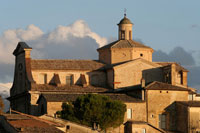
|
|
|
|
|
Montefalco |
|
|
|
Pienza |
| |
|
|
|
|
|
|
![]()
![]()
![]()
![]()

